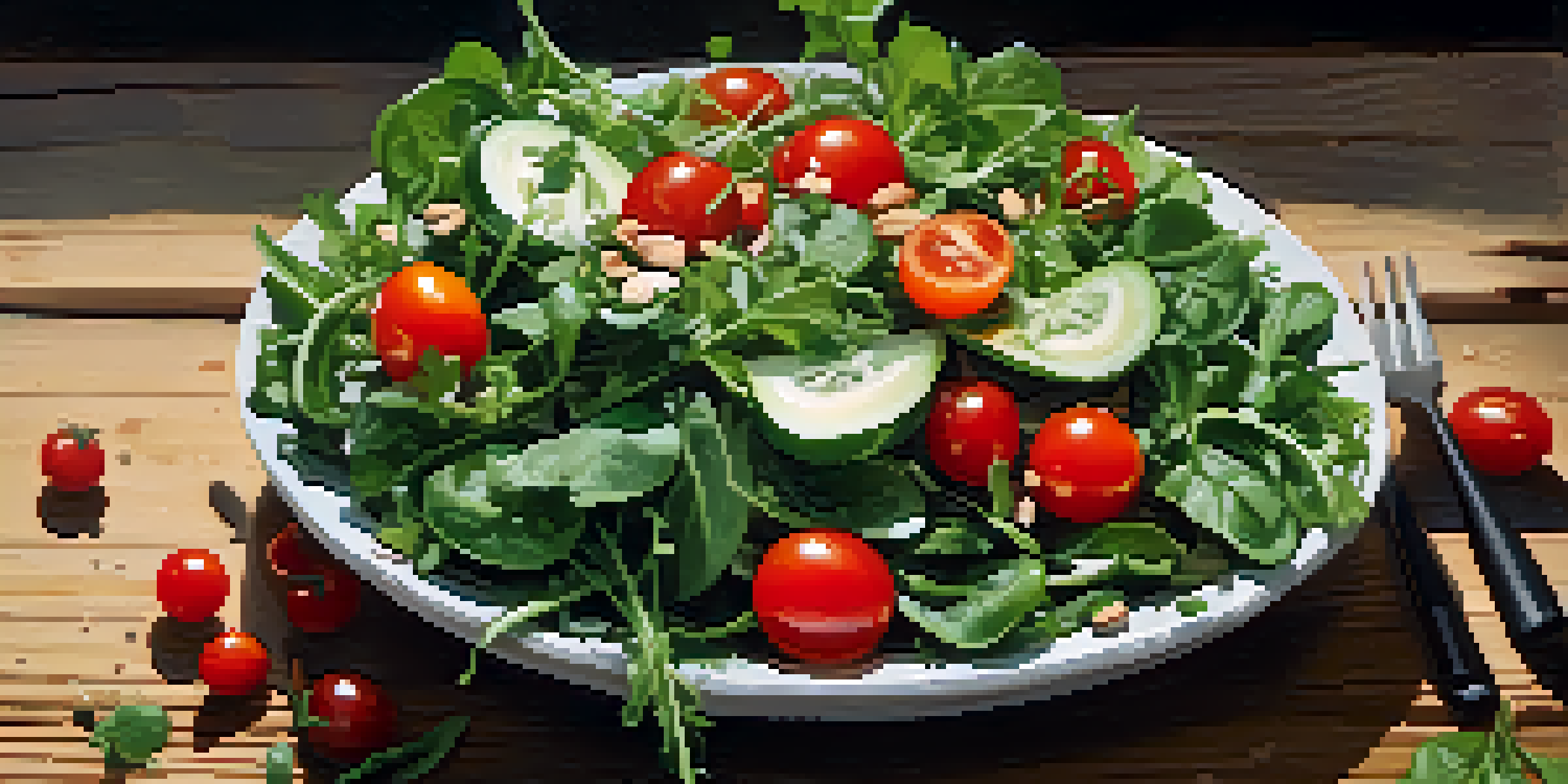Spring Greens: How to Use Seasonal Leaves in Raw Meals

Discover the Nutritional Benefits of Spring Greens
Spring greens, like arugula, spinach, and kale, are powerhouses of nutrition. They’re rich in vitamins A, C, and K, along with minerals like iron and calcium. Eating these leaves raw preserves their nutrients, making them a fantastic addition to your meals.
Let food be thy medicine and medicine be thy food.
Incorporating these greens into your diet can boost your immune system and promote healthy skin. Think of spring greens as nature’s multivitamin, providing a range of health benefits that support overall wellness. Plus, they’re low in calories, making them a great choice for those looking to maintain a healthy weight.
With their vibrant colors and fresh flavors, spring greens not only nourish your body but also uplift your meals visually. Imagine a bright green salad that not only looks appealing but also packs a nutritional punch. This is why including seasonal leaves in your raw meals is a win-win!
How to Choose the Best Spring Greens at the Market
When shopping for spring greens, freshness is key. Look for leaves that are crisp and vibrant, avoiding any that appear wilted or yellowed. Seasonal greens are best enjoyed when they’re at their peak, so visit your local farmers' market or grocery store during springtime.

Don’t hesitate to ask vendors about their greens; they can provide insights into what’s freshest or even share their favorite ways to prepare them. For instance, baby greens are often sweeter and more tender than mature ones, making them ideal for salads and smoothies.
Nutritional Power of Spring Greens
Spring greens like spinach and kale are packed with vitamins and minerals, making them a nutritious addition to your diet.
Also, consider exploring lesser-known varieties like lamb's lettuce or watercress. These unique options can add exciting flavors and textures to your raw meals, elevating your dish from ordinary to extraordinary. Remember, variety is the spice of life, especially when it comes to your plate!
Creative Raw Meal Ideas Featuring Spring Greens
One of the simplest ways to enjoy spring greens is in a fresh salad. Combine a mix of spinach, arugula, and chopped herbs like mint or basil for a light and refreshing dish. Toss in some nuts or seeds for crunch and a drizzle of olive oil and lemon juice to enhance the flavors.
Eating well is a form of self-respect.
Smoothies are another fantastic option! Blend your favorite greens with fruits like bananas or berries for a nutrient-dense drink that’s both delicious and energizing. Add a scoop of protein powder or nut butter for an extra boost, making it a perfect post-workout snack.
Wraps can also be a fun way to enjoy greens. Use large leaves of romaine or collard greens as a healthy alternative to tortillas. Fill them with hummus, grilled veggies, or even quinoa for a satisfying meal that’s easy to eat on the go.
The Importance of Washing and Preparing Greens Properly
Before enjoying your spring greens, proper washing is crucial. Even the freshest leaves can harbor dirt or pests, so rinse them thoroughly under cold water. You can also soak them in a bowl of water to help remove any grit, especially for leafy varieties.
Once washed, drying your greens is just as important. Use a salad spinner or simply pat them dry with a clean kitchen towel. Removing excess moisture ensures your dressings adhere better and prevents sogginess in your salads or wraps.
Choosing and Storing Greens Wisely
Selecting fresh, vibrant greens and storing them properly can enhance their longevity and flavor in your meals.
Finally, consider how you cut or tear your greens. Smaller pieces can make for a more enjoyable eating experience, as they’re easier to chew and mix well with other ingredients. Remember, the way you prepare your greens can significantly affect both flavor and texture in your raw meals.
Pairing Spring Greens with the Right Dressings and Flavors
The right dressing can elevate your raw greens to a whole new level. A classic vinaigrette made with olive oil, vinegar, and a touch of mustard complements the earthy taste of greens beautifully. Experiment with different types of vinegar—balsamic, apple cider, or even citrus—for varied flavors.
Herbs and spices can also enhance the taste of your raw meals. Fresh herbs like dill or parsley add brightness, while spices like cumin or paprika can introduce warmth and depth. Don’t be afraid to mix and match until you find the perfect combination that suits your palate!
Additionally, consider incorporating fruits like citrus or berries into your salads. The sweetness of fruits balances the bitterness of certain greens, creating a harmonious dish. This delightful contrast not only pleases the taste buds but also makes your meals visually appealing.
Storing Leftover Spring Greens for Freshness
To keep your spring greens fresh longer, proper storage is essential. Place unwashed greens in a perforated plastic bag or wrap them in a damp paper towel before sealing them in a container. This helps maintain moisture without making them soggy.
If you’ve already washed your greens, ensure they’re completely dry before storing. Excess moisture can lead to spoilage, so always dry them thoroughly. You can store washed greens in airtight containers lined with paper towels to absorb moisture.
Benefits of Seasonal Eating
Embracing seasonal produce not only supports local agriculture but also enriches your diet with diverse flavors and nutrients.
Regularly check your greens for any signs of wilting or decay. Use the oldest greens first to minimize waste. With a little attention, you can enjoy your spring greens for several days, making it easy to incorporate them into your meals throughout the week.
Embracing Seasonal Eating and Its Benefits
Eating seasonally not only supports your health but also benefits local farmers and the environment. By choosing spring greens, you’re opting for produce that’s at its peak flavor and nutrition. It’s a simple yet impactful way to enhance your meals and your well-being.
Seasonal eating encourages variety in your diet, allowing you to explore different flavors and textures throughout the year. This can keep your meals exciting and help you discover new favorites. Each season offers unique produce, so there’s always something fresh to look forward to.

Moreover, embracing seasonal eating can reduce your carbon footprint. Local produce requires less transportation and storage, promoting sustainability. By making conscious choices about what you eat, you’re not just nourishing your body, but also supporting a healthier planet.